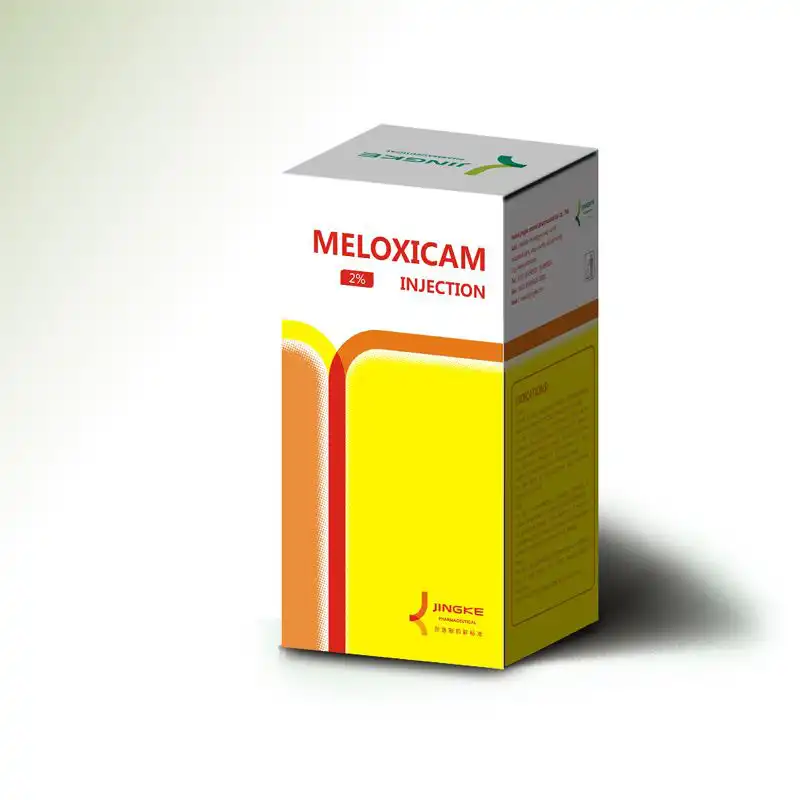What is Meloxicam
Meloxicam is an enolic acid non-steroidal anti-inflammatory drug, an amorphous pale yellow powder with stable chemical properties.
Chemical Name: 4-hydroxy-2-methyl-N-(5-methyl-2-thiazolyl)-2H-1,2-benzothiazine-3-carboxamide-1,1-dioxide.
Molecular Formula: C₁₄H₁₃N₃O₄S₂
Molecular Weight: 351.40
Pharmacology and Pharmacokinetics
This product has antipyretic, analgesic, anti-inflammatory, platelet aggregation inhibition, anti-rheumatic, and gouty kidney swelling treatment effects.
Meloxicam has a selective inhibitory effect on cyclooxygenase-2 (COX-2). Both in vitro and in vivo studies show that meloxicam has a stronger inhibitory effect on COX-2 than on cyclooxygenase-1 (COX-1). Inhibition of COX-1 can cause gastrointestinal and renal adverse reactions as well as antiplatelet effects, while the inhibitory effect on COX-2 is related to its anti-inflammatory properties, thereby achieving its therapeutic effect.
Pharmacokinetics: Oral bioavailability is over 92%, reaching steady-state peak plasma concentration 4-6 hours after administration. Intramuscular injection is rapidly absorbed (bioavailability 100%). The onset time for analgesia by oral or intramuscular administration is 80-90 minutes. Time to peak concentration after a single dose is 0.5-1 hour for intramuscular injection and 4-5 hours for oral administration. 99% is bound to plasma proteins. The half-life is approximately 20 hours for injection and 24-30 hours for oral administration. With daily dosing, the plasma concentration range for a 7.5mg dose in adults is 0.4-1.0 μg/ml. Meloxicam can penetrate into the synovial fluid, where the concentration is approximately half that in plasma. About 99% of the product is metabolized by the liver, and the metabolites are excreted via urine and bile. About 50% is excreted by the kidneys, mainly as inactive metabolites; the other 50% is excreted via feces. Long-term administration does not cause accumulation.
What are the characteristics of Meloxicam?

- Meloxicam is the only internationally approved antipyretic and analgesic drug for all animals, including horses, cattle, sheep, pigs, chickens, dogs, cats, and rabbits, and is included in the European Pharmacopoeia.
- Extremely low cost of use: To achieve the same antipyretic and analgesic effect, meloxicam only needs to be administered once daily at a dosage of 0.1mg per kg of body weight. For a 100kg pig, the cost is only approximately RMB 0.012, while for analgin, which needs to be administered twice daily at 30mg per kg of body weight, the cost for a 100kg pig is RMB 0.42, about 35 times higher. The cost of using flunixin meglumine and aspirin is even higher.
- Extremely safe to use with no residues. High safety profile: Safety tests conducted by China Agricultural University on target animals showed no adverse reactions even at 30 times the recommended dose of meloxicam.
- The European Medicines Agency’s Committee for Veterinary Medicinal Products evaluation of meloxicam indicates that it is a widely approved antipyretic and analgesic drug for use in animals in Europe and is included in the European Pharmacopoeia.
- Wide range of clinical applications: It can be used not only for fever, pain, and inflammation caused by various reasons in horses, cattle, sheep, pigs, dogs, and cats, but also for kidney swelling and urate deposition in chickens, ducks, and geese.
- Can be used as an adjunct to antibacterial and antiviral treatments; it can be used in combination with commonly used antibiotics and antiviral drugs such as penicillin, amoxicillin, cephalosporins, gentamicin, tetracycline, doxycycline, sulfonamides, florfenicol, quinolones, Banlangen, and antiviral drugs.
How is Meloxicam used clinically in veterinary medicine?
- Used for fever, pain, and inflammation caused by various reasons in animals. For kidney swelling and urate deposition in chickens, this product can clear urate and relieve kidney swelling. It is particularly suitable for the treatment of infectious bursal disease and nephropathic infectious bronchitis.
- Indications: Used for various fevers, pain, inflammation, increased endotoxin secretion, and arthritis.
- For unknown high fever, atypical swine fever, porcine reproductive and respiratory syndrome (PRRS), eperythrozoonosis, pleuropneumonia, streptococcosis, etc. in pigs, it can relieve symptoms and has an auxiliary therapeutic effect. Widely used for various bacterial and viral infections with fever.
- For avian influenza, atypical Newcastle disease, infectious bursal disease, infectious bronchitis, etc. in chickens, it can relieve symptoms and has an auxiliary therapeutic effect. Used for the adjunctive treatment of E. coli in chickens and duck serositis with antibiotics to quickly eliminate inflammation and pain. It can be used for anti-heat stress in livestock and poultry. In high summer temperatures, meloxicam can lower body temperature and relieve heat stress.
- For various fevers, inflammation, swelling, rheumatism, and pain in cattle, sheep, dogs, and cats.
- Dosage and Administration: Oral administration, 0.1mg per kg of body weight for large animals and 0.2mg per kg of body weight for small animals, once daily for 3-5 consecutive days. The daily dosage can also be calculated and mixed with an appropriate amount of water or food.
Comparative Advantages of Meloxicam over Other Antipyretic Drugs:
Meloxicam is a fourth-generation non-steroidal anti-inflammatory drug for animals. Compared with first-generation aspirin, second-generation analgin and acetaminophen, and third-generation indomethacin, it has the advantages of being safer to use, requiring lower doses, and having more definite efficacy.

